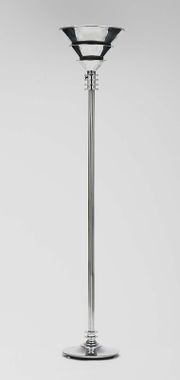Difference between revisions of "Chrome plate"
Jump to navigation
Jump to search
m (Text replace - "== Authority ==" to "== Sources Checked for Data in Record ==") |
|||
| Line 1: | Line 1: | ||
| + | [[File:Chromeplated lamp1985672.jpg|thumb|Chrome-plated lamp<br>MFA# 1985.672]] | ||
== Description == | == Description == | ||
| Line 7: | Line 8: | ||
chromium plating; chromage (Fr.), Verchromung (Deut.); plata cromada (Esp.); cromagem (Port.) | chromium plating; chromage (Fr.), Verchromung (Deut.); plata cromada (Esp.); cromagem (Port.) | ||
| − | == | + | == Resources and Citations == |
* ''Dictionary of Building Preservation'', Ward Bucher, ed., John Wiley & Sons, Inc., New York City, 1996 | * ''Dictionary of Building Preservation'', Ward Bucher, ed., John Wiley & Sons, Inc., New York City, 1996 | ||
Latest revision as of 13:12, 19 August 2020
Description
A thin, shiny metallic surface layer of chromium electrodeposited on other metals, typically nickel. Chrome plating was first developed in 1856 by Geuther by dipping a metal in a chromic acid bath. By 1924, the method was perfected and widely used to create a mirror-like finish. Chrome plating usually has a thickness of 2 - 5 micrometers. It provides a shiny surface that is resistant to corrosion, wear and heat. Small air bubbles between the chrome plating and the base metal can result in tiny black corrosion pits. Chrome plating is used on automobile bumpers, plumbing fixtures, household appliances and sporting goods.
Synonyms and Related Terms
chromium plating; chromage (Fr.), Verchromung (Deut.); plata cromada (Esp.); cromagem (Port.)
Resources and Citations
- Dictionary of Building Preservation, Ward Bucher, ed., John Wiley & Sons, Inc., New York City, 1996
- Tom Rowland, Noel Riley, A-Z Guide to Cleaning, Conserving and Repairing Antiques, Constable and Co., Ltd., London, 1981
